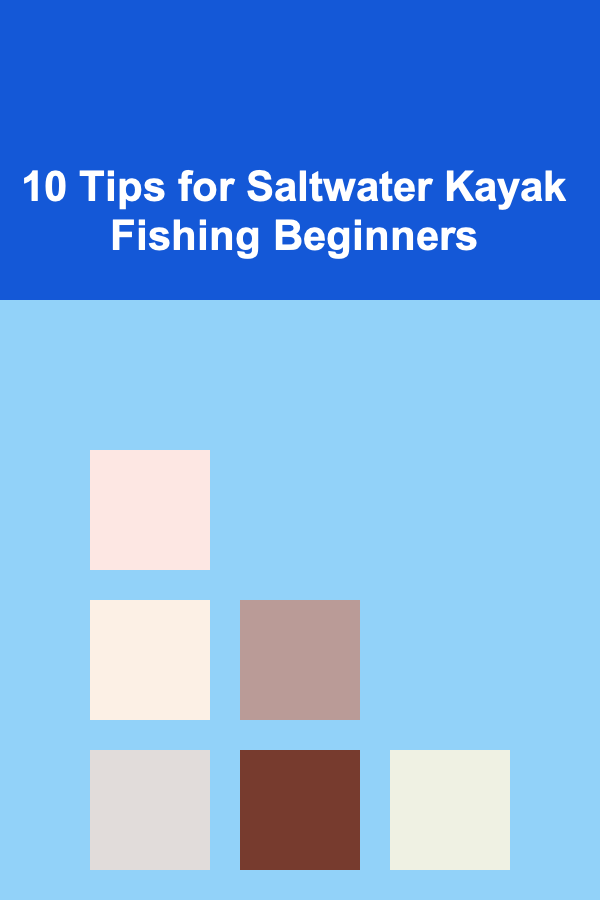
10 Tips for Saltwater Kayak Fishing Beginners
ebook include PDF & Audio bundle (Micro Guide)
$12.99$10.99
Limited Time Offer! Order within the next:

Saltwater kayak fishing is an exhilarating and rewarding outdoor activity that offers anglers the opportunity to fish in diverse and often pristine environments. Whether you're paddling along the coast, casting near reefs, or navigating estuaries, the serenity and adventure of fishing from a kayak is hard to beat. However, for beginners, entering the world of saltwater kayak fishing can be both exciting and intimidating.
This guide provides ten essential tips for saltwater kayak fishing beginners, focusing on techniques, gear, safety, and strategies to enhance your fishing experience. Whether you're just starting out or looking to refine your skills, these tips will ensure a safe and enjoyable kayaking and fishing experience in saltwater environments.
Choose the Right Kayak for Saltwater Fishing
The first step in starting your saltwater kayak fishing journey is selecting the right kayak. Not all kayaks are created equal, and there are several features to consider when choosing one for saltwater environments.
Key Considerations:
- Stability: Stability is paramount when fishing from a kayak, especially in rougher saltwater conditions. Look for kayaks with a wider hull for better balance, making it easier to fish while seated.
- Size and Weight: If you plan to launch from remote beaches or dockless areas, a lightweight kayak that's easy to transport is a huge advantage. However, the larger the kayak, the more room you'll have for gear.
- Durability: Saltwater can be tough on equipment, so ensure the kayak is made from high-quality materials like rotomolded plastic, which is both durable and resistant to corrosion from saltwater.
- Storage: Saltwater kayak fishing requires ample storage space for gear, bait, and your catch. Look for kayaks with built-in compartments and secure bungee cords to hold everything in place.
- Pedal-Drive vs. Paddle Kayaks: Pedal-powered kayaks allow for hands-free navigation, which is ideal when fishing. However, traditional paddle kayaks are lighter and more affordable.
Tip: For beginners, sit-on-top kayaks are a great choice because they're more stable and easier to get in and out of, especially in deeper waters.
Invest in the Right Fishing Gear
While kayaking in saltwater is exciting, fishing from a kayak demands specific gear designed for the conditions. Fishing from a kayak can be different than shore or boat fishing due to the confined space, movement, and potential exposure to saltwater elements.
Key Gear to Consider:
- Fishing Rod: Opt for a medium-heavy rod that can handle a variety of saltwater fish species. A longer rod (7-8 feet) is ideal for casting and distance, while a shorter rod provides more control in tight spaces.
- Reel: A reel with corrosion-resistant materials, such as stainless steel or aluminum, is crucial for saltwater fishing. A spinning reel is often easier for beginners to handle.
- Line: Use a durable, saltwater-resistant fishing line. Braided lines are a popular choice for their strength and low stretch, while fluorocarbon leaders are ideal for clear water.
- Tackle Box: Organize your lures, hooks, and other tackle in waterproof containers to keep everything dry and secure.
- PFD (Personal Flotation Device): A must-have for safety, make sure to choose a PFD that's designed for kayaking and fishing. Look for one with pockets for easy access to tools and accessories.
Tip: Keep your tackle box lightweight and organized. Saltwater fishing can involve long periods of paddling, so minimalism and accessibility are key.
Learn How to Launch Safely
Launching your kayak in saltwater requires some technique and awareness of the conditions. Ocean waves, tides, and currents can make launching tricky for beginners.
Key Launching Tips:
- Avoid Waves: If you're new to kayaking, avoid launching through large waves or breaking surf. Start by launching from a calm bay or dock where the water is more stable.
- Use the Waves to Your Advantage: When launching from a beach, face the waves and paddle with short, strong strokes. If you're coming back to shore, try to time your return with the waves to avoid being capsized.
- Wear a Leash: A leash will ensure that your kayak stays with you if you capsize or get separated from it, especially in moving water.
Tip: Always launch and land with the wind and waves at your back if possible. This helps with control, especially when returning to shore.
Understand the Tides and Currents
Saltwater kayak fishing often occurs in environments influenced by tides, such as bays, estuaries, and coastal waters. Understanding how tides and currents work can greatly impact your fishing success and safety.
Key Considerations:
- Tide Movements: Saltwater fish are highly influenced by the tides. Many fish species feed more aggressively during incoming or outgoing tides. Check tide charts before heading out to plan your fishing trip.
- Currents: Strong currents can make kayaking challenging and may impact your ability to cast effectively. Always check local current forecasts and plan accordingly. Use the current to your advantage by casting into it and letting your bait drift naturally.
- Weather: Be mindful of weather forecasts and the impact of wind on your ability to navigate and control your kayak. Wind can quickly become a problem for kayakers, particularly when combined with strong currents.
Tip: Aim to fish during the first few hours after a tide change, as this is when many saltwater fish are most active and feeding.
Practice Paddling and Maneuvering
Kayaking in saltwater conditions is different than calm freshwater paddling. The constant movement of the water requires more skill to maintain control, especially in wind and waves.
Key Paddling Tips:
- Practice in Calm Waters First: Before heading into saltwater, practice in calm lakes or ponds to develop your paddling technique and balance. Learning how to maneuver your kayak with efficiency will improve your fishing experience.
- Use Proper Paddling Techniques: Paddle with your entire torso, not just your arms, to reduce fatigue and increase stroke power. Efficient paddling will help you cover more distance and navigate through tricky waters.
- Learn How to Turn: Master the art of quick turning using sweep strokes or reverse strokes. This will help you navigate around obstacles or quickly change your fishing position.
Tip: Invest in a kayak with a rudder or skeg to improve your steering control, especially in windy conditions.
Focus on Safety First
While saltwater kayak fishing can be an enjoyable and safe activity, there are inherent risks. Safety should always be your top priority when fishing from a kayak.
Essential Safety Gear:
- Life Jacket: Always wear a properly fitted PFD while kayaking. Even if you're an experienced swimmer, accidents can happen, and wearing a life jacket is critical for safety.
- Whistle: Carry a whistle or sound-producing device to alert others if you need help. This is a necessary item for emergency situations.
- First-Aid Kit: Have a small first-aid kit on board to treat any minor injuries, including cuts or abrasions that can happen when handling fishing hooks or during paddling.
- Communication Device: Carry a waterproof VHF radio or a fully charged phone in a dry bag in case you need to communicate with others in an emergency.
Tip: Always let someone know your plans before you head out and when you expect to return. This provides an extra layer of safety in case something goes wrong.
Learn to Fish for Saltwater Species
Saltwater fishing opens up a wide range of species to target, each with their own specific habits and fishing methods. As a beginner, it's crucial to start by learning about the fish species in your area and understanding their feeding behaviors.
Common Saltwater Species to Target:
- Redfish: A popular choice for beginners, redfish are known to be aggressive feeders and are often found near coastal flats, oyster bars, and estuaries.
- Snook: Snook are commonly found in warmer coastal waters and are known for their strong fight. They often feed around structures like docks or mangroves.
- Trout: Spotted sea trout are a great species for beginners and are commonly found in shallow waters. They are particularly active during the early morning and late afternoon.
- Flounder: Flounder are bottom dwellers and are often found near sandy or muddy bottoms. They are best targeted with soft plastics or live bait.
Tip: Research local fishing regulations, including seasonal restrictions and bag limits, to ensure you're fishing legally and sustainably.
Use Effective Bait and Lures
Choosing the right bait or lure is essential for attracting fish. Saltwater fish are typically attracted to live bait, but lures can also be highly effective.
Best Types of Bait:
- Live Bait: Live shrimp, mullet, and small baitfish are great for attracting a variety of saltwater species. Live bait can be used with a simple rig or a float.
- Artificial Lures: Soft plastics, crankbaits, and topwater lures can mimic the movement of small fish and are highly effective for targeting specific species. Consider the color and size of the lure based on the water clarity and the target species.
Tip: Match your lure or bait to the local baitfish species in your area for the best chance of success.
Adapt to Changing Conditions
Saltwater fishing conditions can change quickly due to factors like weather, tides, and fish behavior. Successful anglers know how to adapt to these changes to maximize their chances of success.
Adaptive Strategies:
- Change Locations: If you're not having luck in one area, don't hesitate to move. Fish are constantly moving, and finding a new spot may increase your chances of a catch.
- Switch Techniques: If one technique isn't working, try another. Change your bait, alter your casting distance, or experiment with different retrieval speeds for artificial lures.
- Observe Fish Behavior: Look for signs of fish activity, such as jumping or surface ripples, to help you pinpoint where to cast.
Tip: Always be prepared to adjust your plan based on the conditions. Flexibility and patience are key to successful saltwater kayak fishing.
Respect the Environment and Fish Responsibly
Saltwater kayak fishing offers an incredible opportunity to connect with nature, but it's crucial to fish responsibly and respect the environment.
Best Practices:
- Catch and Release: Practice catch and release for species that are not in season or that you don't plan to eat. Use barbless hooks to minimize harm to the fish.
- Minimize Impact: Be mindful of fragile ecosystems like coral reefs and seagrass beds. Avoid disturbing marine life and always follow local environmental guidelines.
- Clean Up: Always clean up after yourself and dispose of trash properly. Saltwater environments are sensitive, and pollution can have lasting effects on marine life.
Tip: Leave no trace and be a responsible angler by following local regulations and environmental guidelines.
Conclusion
Saltwater kayak fishing offers an exciting and unique way to connect with nature and enjoy the thrill of fishing in the open water. By selecting the right kayak, investing in essential gear, understanding the tides and currents, and practicing key fishing techniques, beginners can set themselves up for success.
By prioritizing safety, adapting to changing conditions, and respecting the environment, you'll not only have a rewarding experience but also help preserve the saltwater ecosystems that make this sport so special. Happy fishing!
Reading More From Our Other Websites
- [Home Maintenance 101] How to Perform Routine Checks on Your Home's Foundation
- [Organization Tip 101] How to Achieve a Clean and Calm Workspace with Minimalist Design
- [Biking 101] How to Choose the Best Downhill Bike for Extreme Terrain
- [Tie-Dyeing Tip 101] The Science Behind Crumple Tie-Dye: How Folding Affects Color Flow
- [Home Maintenance 101] How to Maintain Your Kitchen Appliances in Winter
- [Home Storage Solution 101] How to Implement Kitchen Storage Ideas That Save Space and Time
- [Home Maintenance 101] How to Keep Your Home's Lawn Irrigation System Running Smoothly
- [Sewing Tip 101] Troubleshooting 101: Common Sewing Machine Problems and Easy Fixes
- [Home Staging 101] How to Stage Your Home to Attract Young Professionals
- [Stamp Making Tip 101] Why a Custom Stamp is the Secret Weapon for Consistent Logo Presentation

How to Create a Compelling Call-to-Action on a One-Page Website
Read More
How To Develop Your Character's Motivations
Read More
How to Organize a Crafting Space for Creative Expression
Read More
How to Draw Architectural Interiors
Read More
How to Review and Revise Your Investing To-Do List Regularly
Read More
How to Plan a Bridal Shower Checklist for the Bride Who Hates Being the Center of Attention
Read MoreOther Products

How to Create a Compelling Call-to-Action on a One-Page Website
Read More
How To Develop Your Character's Motivations
Read More
How to Organize a Crafting Space for Creative Expression
Read More
How to Draw Architectural Interiors
Read More
How to Review and Revise Your Investing To-Do List Regularly
Read More